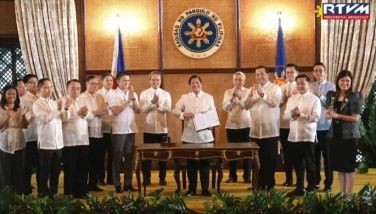Keeping the price of rice reasonable and steady

The government decided to propose that the National Food Authority (NFA) be given the right to import rice and to maintain a buffer stock to assure that the price of rice can be kept more stable.
House Bill 10381 which seeks to amend the Rice Tariffication Law which has been approved in the House of Representatives is the instrument to undertake this. The issue is now at the Senate.
The proposal aims to restore to the NFA the power to import rice as an agency under conditions of emergency. The private trader importation of rice under the RTL continues.
NFA’s record
By mandate, NFA was to keep the price of rice low and affordable for final consumers.
But at the farm level, NFA bought the palay produce of farmers at a price high enough so that farmers could earn good incomes at harvest time. The procured palay was milled (mostly by private contractors at cost) and kept as part of the rice buffer stock for the nation.
Essentially, this aspect of the domestic operations often led to major losses for NFA, for it bought at high prices from farmers and sold the buffer stock at low prices for domestic market sales.
This is the essence of old-style rice price stabilization. Sustaining this type of operation required a subsidy from the government.
The fact is that domestic rice agriculture has not been able to keep in pace with population growth. Over the decades, the importation of rice had become an essential and important component of NFA operations.
The NFA law gave the agency the authority to determine the total stock of rice needed and to estimate what – year-by-year – the total supply of rice for the nation would be. That sent the signal for the gap in supply, which had to be imported. And NFA could then import the estimated need, as it had the monopoly to make that decision.
Also, NFA had complete control of government interventions on rice pricing. For example, throughout the years 2010 to 2020, Filipinos paid about twice as much for rice than the citizens of Thailand and Vietnam. These countries are very efficient in rice agriculture and are therefore low-cost rice producers. The opportunities for NFA’s gains from its international import trading operations are substantial.
Through the years, this was NFA’s role in the rice market. Such practice, although it often led to relatively low domestic prices for rice, had suffered from many problems.
Stakeholders on the rice issue were strongly divided on NFA’s achievements. Farmers and rice miller groups complained. When rising prices resulted, the complaints came from urban rice consumers. Of course, those few groups that benefited from NFA’s operational activities defended the agency.
Serious problems of governance (read: corruption) had been a constant theme of these complaints, however. Many of these arose from the exercise of its monopoly and regulatory powers.
Eventually, during bad times when the demand from price control authorities required consumer subsidies, even the profits from international trading vanished. The result then became a serious fiscal problem because deficits of the agency were charged to the government’s fiscal deficits.
NFA has many names
Though I used NFA as the grain price regulator, it had many names in the country’s economic history. The agency is a political creation of the government to deal with price stabilization of the country’s staple grain.
It is the plan to help assure consumers of rice that they would have a low domestic price.
Further, it is a plan to help farmers also have a fair deal as producers of the nation’s main staple. As in the past, the plan to restore its importing and domestic grain operations is essentially the same.
During the Commonwealth and early independence years, it was known as NARIC (National Rice and Corn Corp). When it had to be resuscitated, it was renamed RCA (Rice and Corn Administration). Then it was renamed NGA (National Grains Authority), again, to give it a new rebirth.
Each episode of rebirth under another name was due to the bad fiscal outcomes – budget deficits. Even as the agency was abolished, the political objective of domestic price stabilization still remained. The solution always led to the agency’s administrative rebirth in new clothing. The more things change, the more they stay the same.
Rice Tariffication Law of 2019
Not too long ago, the government responded to calls for a reform of the market regulations covering rice.
This clearly affected the operations of the NFA.
The RTL defanged the NFA by abolishing its monopoly power to import rice completely. In its place, a new import regime relied on imports by private traders under hefty tariffs of 35 percent.
The rate of tariff reflects the disparity in productive efficiency of Philippine rice agriculture compared to those from which imports are sourced, mainly from countries within ASEAN.
The revenues from tariff were constituted into a fund to supplement the government’s domestic program of rice production, a help to farmers.
As long as domestic price stabilization is based on reasonable, not unsustainable, price targets, most economists would agree that the reforms undertaken under the rice tariffication law are sufficient.
Countries that have open markets do not suffer from supply deficiencies in certain goods as long as they can import these since they earn good income on other pursuits.
Tariffication of imports allows for disparities in production efficiency to allow for the protection of domestic interests that are essential to their national survival – in this case, protecting the domestic rice industry to achieve national food security.
In short, as long as the regime of relatively free importation of grain is sustained, perhaps NFA’s regaining of the power to import rice during emergency situations is granted.
However, if this power is used to implement an unsustainable domestic price of rice at a low price, all will be lost back to the story of the old NFA.
For archives of previous Crossroads essays, go to: https://www.philstar.com/authors/1336383/gerardo-p-sicat. Visit this site for more information, feedback and commentary: http://econ.upd.edu.ph/gpsicat/
- Latest
- Trending


























 Exclusive
Exclusive